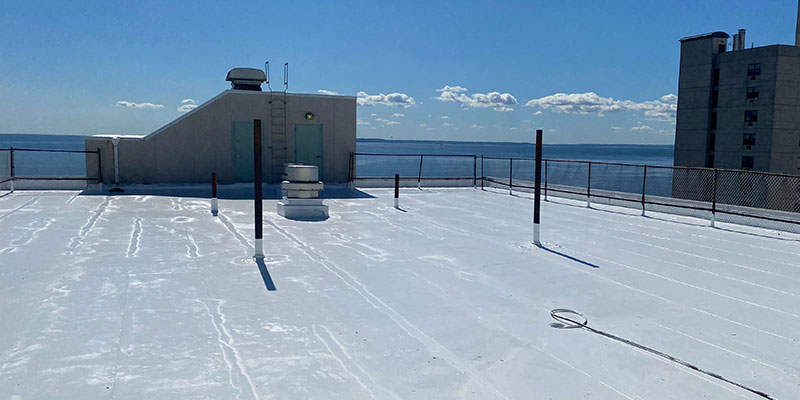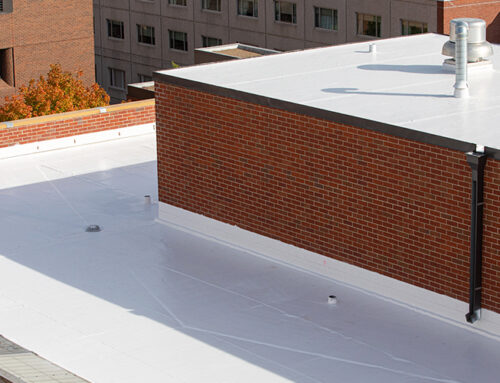Liquid rubber roof coating has a long list of benefits, including fire resistance, UV and ozone resistance, solar reflectivity, a waterproof membrane, expandability and corrosion resistance. It’s easy to apply, too, especially when you use one of our vetted contractors for the job. Let’s get further into the benefits:
Versatile. Use rubber roof coatings with almost any type of roof, and for any kind of application, whether that’s roof restoration, a topcoat over another material or mending small areas.
Strong. It’s stronger and more durable than other types of liquid coatings. The best liquid rubber roof coatings can stand up to more severe weather events, heavier foot traffic and years of consistent weather exposure before damage occurs. Rubber roof coatings have a Class A fire rating, meaning they are fire-resistant, as well.
Reflective. Coatings’ reflectiveness can save up to 40% in energy costs. Inland’s white roof coatings reflect UV rays away from the building, keeping the roof and building cool. They are also highly ozone and UV resistant, which prolongs the lifespan of the coating. Rubber coatings are available in other colors as well, and certain products can be color-matched. Color matching is the perfect way to create a unique, complementary shade for your application.
Seamless. A liquid application equates to a seamless application. There are no seams, so you don’t have to worry about seams failing over time. Other roofing applications are applied in strips, allowing moisture to filter through the seams. If water were to get through rubber roof coating, it would be through an unlikely crack in the material.
Waterproof. Once cured, water cannot penetrate the rubbery material. That means pooling water is no longer an issue, nor is the formation of algae or fungi.
Rubber sealants are often also referred to as SEBS, which stands for Styrene Ethylene Butylene Styrene. Inland’ rubber roof product lineup differs based on the roof type. For example, the coating adheres better to single-ply and metal roof types with a base coat. We also carry a specialized topcoat for metal roofs that reinforces the waterproofing, UV resistance and thermally stable properties of the coating itself. Those looking to make repairs instead of undergoing an entire restoration process have the rubber seam compound, premium seam compound or seam tape to choose from.
Here’s why liquid rubber roof coatings are a good match for several common roof types:
Metal
Even if your metal roof has damage from years of battling the elements, you can apply roof sealants to protect it and extend its lifespan.
Hypalon Single-Ply
Hypalon roofs need extra protection from the sun to prevent chalking from happening and cracks and pinholes from forming. Rubber roof application can repair current imperfections while protecting against future damage.
EPDM Single-Ply
EPDM roofs are prone to leaking if they experience excess foot traffic or weather exposure, but liquid EPDM rubber sealant is durable enough to eliminate these costly side effects.
TPO Single-Ply
TPO roofs are susceptible to UV and moisture damage, making them a perfect candidate for rubber coating.
Modified Bitumen & BUR
Liquid rubber waterproof sealants help prevent issues caused by moisture, sun and heat in modified bitumen and BUR roofs. Cracks and leaks become a problem of the past.
Spray Polyurethane Foam
Spray polyurethane foam roofs don’t stand up well to harsh weather conditions, but liquid rubber roof coatings can help strengthen them.
When you choose Inland’s commercial coatings, you’re getting the best liquid rubber roof coating on the market. Contact our experts if you have questions or are unsure whether it’s the right product for your building.
If you’re ready to start planning a coating project, our team can help with that, too. We’ll take it step by step, listening to your situation in order to determine the right solution. If you’d like to speak with a team member directly, call 800-456-8467.
Frequently asked questions
Is liquid rubber a good roof coating?
Yes, liquid rubber is a high-quality roof coating material. It provides waterproofing, is easy to apply, is cost-efficient and is environmentally friendly. It allows building owners an alternative to costly roof replacement that’s just as effective in protecting the building from rain, wind and sun exposure.
How long does liquid rubber last on a roof?
The best liquid rubber roof coating lasts 15 to 25 years, depending on the thickness and quality of the application. The material needs to be applied in thin layers, but the more layers are applied, the longer the roof will last.
Once those 15 to 25 years have passed, though, you can recoat the roof to extend its lifespan even further. Recoating involves power-washing, making any necessary repairs and applying a new thin layer of coating on top of the existing layer. Doing so allows the roof to last for another 15 to 25 years.



